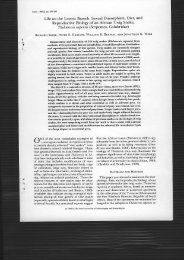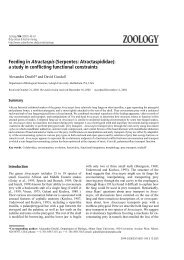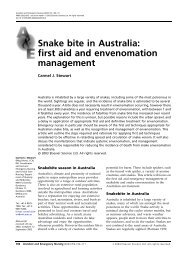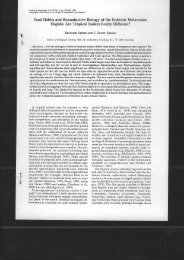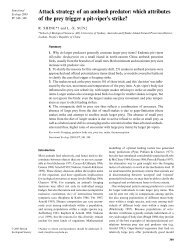Introduction - Kingsnake.com
Introduction - Kingsnake.com
Introduction - Kingsnake.com
Create successful ePaper yourself
Turn your PDF publications into a flip-book with our unique Google optimized e-Paper software.
Clinical Management of Snakebite in Papua New Guinea Chapter 1<br />
hours. The range of ventilation times was between 2 and 23.5 hours, considerably less than<br />
for victims of Papuan taipans (Oxyuranus scutellatus canni). Lalloo et al (1995a) reported<br />
that the median ventilation time after bites by Papuan taipans was 88 hours with a range of<br />
from 3 to 176 hours.<br />
Hudson & Pomat (1988) reported ptosis as a symptom in 55% and as a sign in 53% of<br />
snakebite envenomations in Madang province. Dysphagia and dysarthria were symptoms in<br />
31%, and 20% reported diplopia. Respiratory distress was a symptom in 9% of bites. Other<br />
signs included bulbar paralysis (17%) and external ophthalmoplegia (13%). Only 5% of<br />
patients subsequently developed respiratory failure. The only highly venomous species in the<br />
province are death adders (Acanthophis spp.) and small-eyed snakes (Micropechis ikaheka).<br />
Hudson (1988a) reports <strong>com</strong>plete bilateral ptosis, ophthalmoplegia and paralysis of tongue,<br />
jaws and pharynx in a man bitten by a death adder. Peripheral limb weakness was present as<br />
well as paralysis of the intercostal muscles. Hudson (1988b) reports bilateral ptosis,<br />
ophthalmoplegia, diplopia, bulbar and peripheral paresis in two patients presumed to have<br />
been bitten by small-eyed snakes (Micropechis ikaheka) in Madang province. Respiratory<br />
distress was evident in both patients, and one of them, a 13 year old girl, eventually died from<br />
cardiorespiratory failure 42 hours port bite. Resolution of ptosis, bulbar paresis and limb<br />
weakness took more than 14 days in the other patient despite the use of a large quantity of<br />
antivenom.<br />
The study of Papuan taipan (Oxyuranus scutellatus canni) envenomation by Lalloo et al<br />
(1995a) remains the most <strong>com</strong>prehensive investigation of neurotoxicity by this large and very<br />
dangerous snake. Of 166 patients with confirmed bites by taipans, 139 (83.7%) developed<br />
signs and symptoms of envenomation. Ptosis was present in 84/131 (64.1%) patients and was<br />
the most frequently reported symptom followed by dysarthria in 39/121 (32.2%) and<br />
dysphagia in 39/124 (31.5%). Diplopia was reported in 26/120 (21.7%) and 17/121 (14%) had<br />
dyspnoea; 41.7% of patients required intubation as paralysis deepened, and ventilation was<br />
required by 36.7% of envenomed patients. Progression to the point where intubation was<br />
required ranged from 3 to 55 hours with a median time point of 13.5 hours.<br />
FIGURE 6: Comparison of clinical signs of neurotoxicity after the EIA-proven bites of three different species of<br />
highly venomous Papua New Guinean snakes. (SOURCES: Lalloo et al, 1994; Lalloo et al, 1995a; Lalloo et al, 1996)<br />
100<br />
90<br />
80<br />
Papuan taipan (n=105-139)<br />
Death adder (n=18)<br />
Papuan blacksnake (n=9)<br />
70<br />
Percentage<br />
60<br />
50<br />
40<br />
30<br />
20<br />
10<br />
0<br />
Ptosis<br />
Ophthalmoplegia<br />
Jaw Restriction<br />
Slurred Speech<br />
Reduced hand<br />
grip<br />
Diminished<br />
reflexes<br />
Intubation<br />
Ventilation<br />
- 1.21 -




